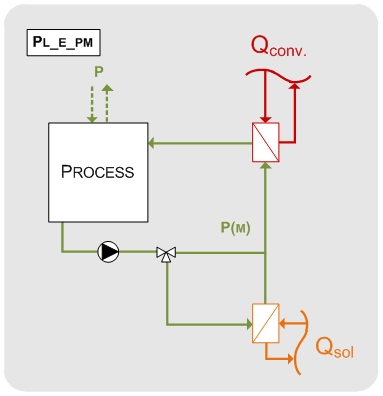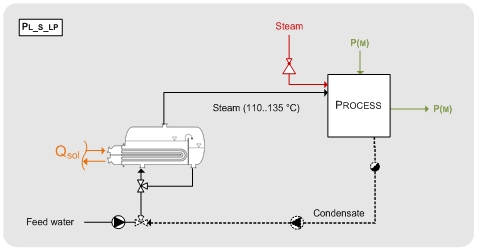The printable version is no longer supported and may have rendering errors. Please update your browser bookmarks and please use the default browser print function instead.
Back to EFFICIENCY FINDER
| Different process technologies exist within industry, which lead to several possibilities for the integration of solar heat. Based on the general classification of industrial heat consumers drying processes are assigned to the category “Thermal separation processes”. By consideration of the conventional heat supply, different integration concepts are possible.
|

|
PL_E_PM - external HEX for heating of product or process medium
This integration concept is basically the easiest since an additional solar driven heat exchanger is installed in serial to the conventional heat exchanger to heat a product or process medium (e.g. water, lye, fruit juice, etc.). It can be applied to all three categories of heat consumers “(pre)heating of fluid streams”, “heating and maintaining temperature of baths, machineries or tanks” and “thermal separation processes”. The serial integration of a solar driven heat exchanger can be realized in a way that only part of the entire product or process medium stream is heated up and hence heat exchanger surface, pump and pipe dimensions can be kept small.
|

|
PL_S_V solar steam generation at vacuum
Solar steam generation with vacuum can be applied for numerous evaporation processes e.g. in food and beverage industry, since typical process temperatures are in the range of 40 - 80 °C. Therefore, an evacuated storage with a conventional heat exchanger is required. The condensate from evaporation process is preheated by solar energy and fed into the evacuated storage. The evaporated condensate is fed back into the evaporation process.
|

|
PL_S_LP solar steam generation at low pressure
For solar steam supply with reduced pressure of 1.5 - 3 bar (according to 110 - 135 °C) a kettle reboiler is required that is supplied with solar heat. Feed water or condensate is fed into the reboiler, evaporated and used to heat the process. Therefore, the conventional steam demand for injection heating is reduced. Based on the required installations this integration concept is similar to SL_S_PI on supply level. The only difference is the reduced temperature level compared to conventional steam systems in Industry. Therefore, this integration concept can also be applied under moderate climatic conditions.
|
| Source: Schmitt, B., 2014. Integration of solar heating plants for supply of process heat in industrial companies (in German language), Dissertation University of Kassel, Shaker Verlag, Aachen, Germany.
|
Back to EFFICIENCY FINDER